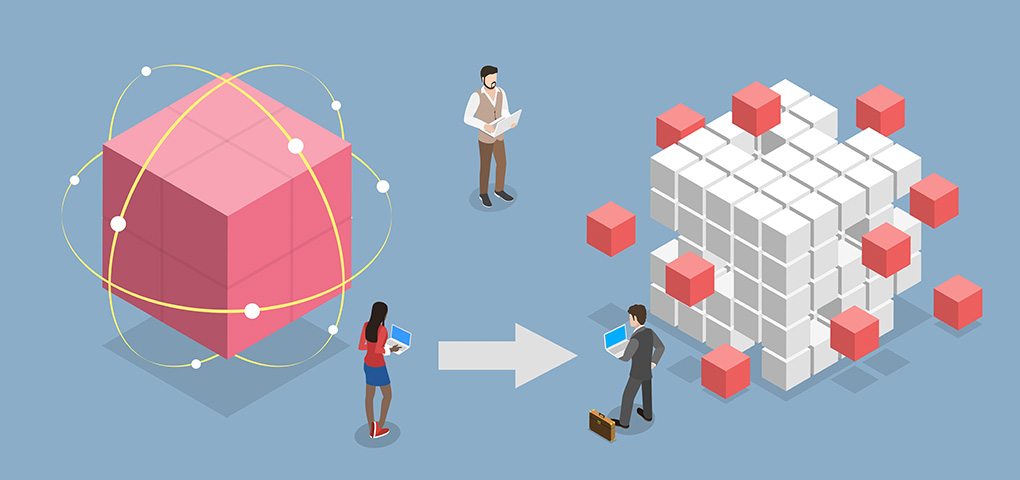
Is MACH/headless eCommerce right for you?

To celebrate the launch of Avatria’s new composable commerce accelerator, Zocalo, we wanted to share a few blog posts about some of the thinking that guided our development of the tool.
When it comes to eCommerce architecture, there are two main options: traditional (also known as monolith) and headless. Traditional eCommerce architecture relies on a single platform to handle all core functionalities of the website, including the frontend user interface. Monolith platforms can take several forms—from legacy, enterprise-focused platforms such as SAP Commerce, to upstart platforms targeted at small and mid-sized businesses like Shopify, to industry-specific platforms focused on specialized use cases, such as reservation-management systems
In contrast, headless eCommerce separates the frontend and backend components, allowing for more flexibility in choosing the tools and vendors to use. MACH (Microservices, API-first, Cloud-native SaaS, Headless) architecture is a specific approach to web development that relies of a combination of technologies to construct a website. Whereas monolith architecture relies on the central platform for content management, merchandising, and other core features, in a MACH architecture, each of these functionalities would be handled by a distinct platform.
Before selecting an eCommerce platform, a business first needs to determine the type of architecture that best suits its needs. With the increasing popularity of headless platforms, we field a lot of questions from clients about MACH architecture. With that in mind, we’ve assembled a brief overview of the advantages and disadvantages of each approach, along with some key considerations to help guide the discussion when your tech team is debating the relative merits.
Pros & Cons of Traditional Commerce
Monolith eCommerce platforms have been around for decades, and have long been the architecture of choice for the majority of online businesses. As a result, many traditional commerce platforms often have a more mature product offering, which means they offer more configuration options for businesses that don’t require custom-built solutions. However, keep in mind that is very much platform dependent; newer tools such as Shopify have managed to carve out a niche by offering pared-down functionality.
Because everything is integrated into a single platform, the architecture is often simpler to understand, and there are fewer distinct tools to manage. This also creates a streamlined billing process that can be beneficial for businesses that don’t have the resources to manage multiple vendors. This doesn’t necessarily mean a monolith solution is cheaper, though. The cost of unused functionality will often be baked into the pricing of an enterprise platform, and stripped-down platforms frequently require subscriptions to third-party apps or extensions to cover functionality that the platform doesn’t support out of the box.
Pros & Cons of Headless Commerce
The core advantage headless commerce offers is a greater flexibility in almost every area. Take vendor selection, for example—because the frontend and backend are decoupled, businesses can choose the best tool for each job. This can result in budgetary advantages as well, as a businesses can pay for only the functionality required for their site, or select cheaper options for non-core functions.
Flexibility is a major advantage in the development process as well. With MACH architecture, it is significantly easier to take a crawl, walk, run approach to executing your roadmap. Because functionality is compartmentalized, it is easier and safer to add in new functionality, reducing development timelines and testing loads. The work we did for AmerCareRoyal is a perfect example of this benefit in action.
Headless commerce platforms are also cloud-native, which means they’re designed to run in a cloud environment. In addition to increasing operational efficiency, cloud hosting improves site security, scalability, reliability, and performance. Furthermore, headless commerce platforms allow businesses to choose the programming language they prefer, which can make development easier for businesses that have a preference for specific programming languages.
Which is right for you?
As we’ve shown above, there are upsides and drawbacks to both type of eCommerce architecture. When deciding which is best for you, it’s crucial to start with who you are. Here are some key questions to guide your thinking:
How important is UX to your website?
Because the frontend is disconnected from the backend, MACH architecture often enables faster development of new experiences. This can be an advantage for businesses that value speed and flexibility.
What tools does your team need?
If your team is looking for greater choice when it comes to selecting a CMS, CDP, Search engine, or PIM, a MACH approach may be right for you. These functions are typically built into a monolith platform, and attempting to introduce a third-party may result in extensive development effort and additional costs.
Similarly, if your business sells configurable products, it may be easier to connect to a customization engine with MACH.
What does your organization structure look like?
If you have a big on-premises team, traditional commerce may be a better fit. However, if your team is cloud-based, headless commerce may be more practical because it doesn’t require as much investment in a dedicated on-premises team.
Furthermore, if your team has a preference for a specific programming language, MACH won’t force a switch to a new language.
We get a lot of questions related to business type, with some clients under the impression that MACH isn’t well suited to B2B businesses, or certain industries. Don’t be fooled—in our experience, this is a gross oversimplification on the real issues at play. Some B2B businesses may benefit greatly from opting for a MACH approach, much as some others may struggle to find value from it.
Conclusion
Ultimately, the perceived newness and complexity of headless commerce and MACH architecture can make it challenging to convince stakeholders to adopt it, even if the overall benefits are favorable. This is why we built Zocalo. Zocalo was designed to bridge the gap between traditional and headless commerce, offering pre-built business logic and API endpoints for core commerce functionality. This results in a simplified architecture and faster development.
While we hope this post has been helpful, we know it’s far from the whole story on monolith versus headless eCommerce. If you’re unsure which option is right for your business, Avatria offers short-engagement vendor selection and solution architecture projects to help guide you through the decision-making process. Our contact information is below—don’t hesitate to reach out!
